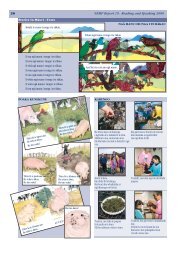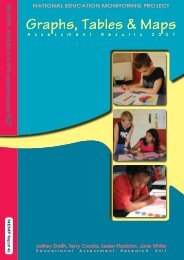mathematics
Mathematics 2001.pdf [33.7 MB] - NEMP - University of Otago
Mathematics 2001.pdf [33.7 MB] - NEMP - University of Otago
- No tags were found...
You also want an ePaper? Increase the reach of your titles
YUMPU automatically turns print PDFs into web optimized ePapers that Google loves.
8 NEMP Report 23: Mathematics 2001<br />
Analysis of results<br />
The results are analysed and reported task by task.<br />
Although the emphasis is on the overall national picture,<br />
some attention is also given to possible differences in<br />
performance patterns for different demographic groups<br />
and categories of school. The variables considered are:<br />
➢ Student gender: male, female<br />
➢ Student ethnicity: Māori, non-Māori<br />
➢ Geographical zone: Greater Auckland, other<br />
North Island, South Island<br />
➢ Size of community: urban area over 100,000,<br />
community of 10,000 to 100,000, rural area or<br />
town of less than 10,000<br />
➢ Socio-economic index for the school: bottom three<br />
deciles, middle four deciles, highest three deciles<br />
➢ Size of school:<br />
year 4 s c h o o l s less than 20 Y4 students 20–35 Y4 students more than 35 Y4 students<br />
year 8 s c h o o l s less than 35 Y8 students 35–150 Y8 students more than 150 Y8 students<br />
➢ Type of school (for year 8 sample only): Full primary<br />
school, intermediate school (some students<br />
were in other types of schools, but too few to<br />
allow separate analysis)<br />
Categories containing fewer children, such as Asian students<br />
or female Māori students, were not used because<br />
the resulting statistics would be based on the performance<br />
of less than 70 children, and would therefore be<br />
too unreliable.<br />
A further subgroup analysis has also been included. This<br />
compares the performance of Pacific,<br />
Māori and other students attending<br />
schools with 15 percent or more Pacific<br />
students enrolled. Schools in this category<br />
within the main samples are combined<br />
with the supplementary samples<br />
of 10 schools with 20 percent or more<br />
Pacific students enrolled. The resulting<br />
samples include about 105 students<br />
attempting each task: typically about 50<br />
Pacific students, 25 Māori students and<br />
30 other students.<br />
Funding arrangements<br />
National monitoring is funded by the<br />
Ministry of Education, and organised by<br />
the Educational Assessment Research<br />
Unit at the University of Otago, under<br />
the direction of Associate Professor<br />
Terry Crooks and Lester Flockton. The current contract<br />
runs until 2003. The cost is about $2.5 million per year,<br />
less than one tenth of a percent of the budget allocation<br />
for primary and secondary education. Almost half of the<br />
funding is used to pay for the time and expenses of the<br />
teachers who assist with the assessments as task developers,<br />
teacher administrators or markers.<br />
Reviews by international scholars<br />
In June 1996, three scholars from the United States and<br />
England, with distinguished international reputations in<br />
the field of educational assessment, accepted an invitation<br />
from the Project directors to visit the Project. They<br />
conducted a thorough review of the progress of the<br />
Project, with particular attention to the procedures and<br />
tasks used in 1995 and the results emerging. At the end<br />
of their review, they prepared a report which concluded<br />
as follows:<br />
The National Education Monitoring Project is well conceived<br />
and admirably implemented. Decisions about design, task<br />
development, scoring, and reporting have been made thoughtfully.<br />
The work is of exceptionally high quality and displays<br />
considerable originality. We believe that the project has considerable<br />
potential for advancing the understanding of and public<br />
debate about the educational achievement of New Zealand<br />
students. It may also serve as a model for national and/or state<br />
monitoring in other countries.<br />
Professors Paul Black, Michael Kane & Robert Linn, 1996<br />
A further review was conducted late in 1998 by another<br />
distinguished panel (Professors Elliot Eisner, Caroline<br />
Gipps and Wynne Harlen). Amid very helpful suggestions<br />
for further refinements and investigations, they<br />
commented that:<br />
We want to acknowledge publicly that the overall design of<br />
NEMP is very well thought through. … The vast majority of<br />
tasks are well designed, engaging to students and consistent<br />
with good assessment principles in making clear to students<br />
what is expected of them.<br />
Further information<br />
A more extended description of national monitoring,<br />
including detailed information about task development<br />
procedures, is available in:<br />
Flockton, L. (1999). School-wide Assessment: National<br />
Education Monitoring Project. Wellington: New Zealand<br />
Council for Educational Research.






